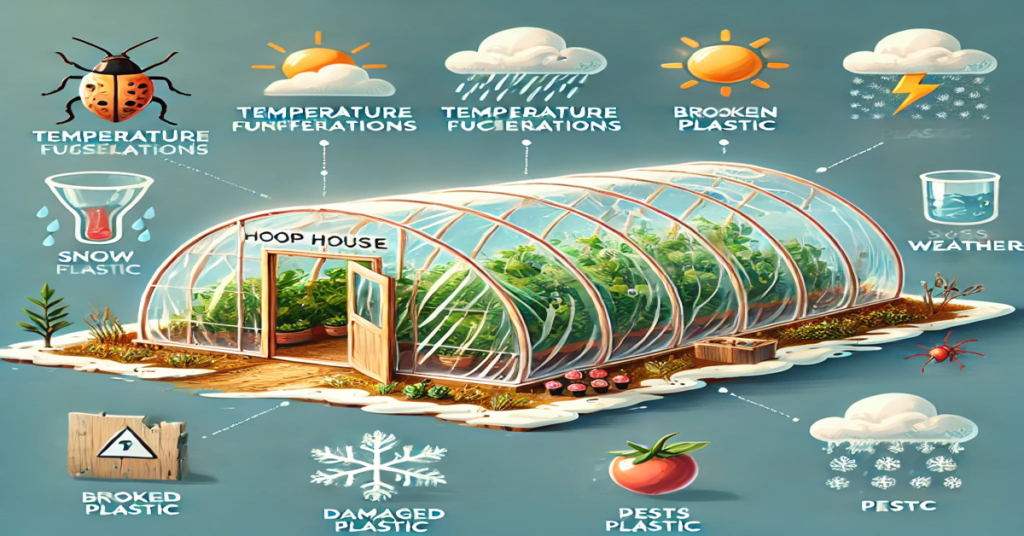In the world of modern agriculture, hoop houses (also known as high tunnels or polytunnels) are an increasingly popular option for extending the growing season, protecting plants from extreme weather, and increasing crop yields. These structures, typically made of metal frames covered with plastic sheeting, allow farmers and gardeners to cultivate plants in a controlled environment that mimics the conditions of a greenhouse but at a fraction of the cost.
However, like any agricultural practice or technology, hoop houses are not without their disadvantages. While they can offer significant benefits, including enhanced crop production, water conservation, and protection from pests, there are several challenges and limitations associated with hoop houses. This article explores these disadvantages in detail, helping potential hoop house users to make informed decisions about whether these structures are right for their farming needs.
What Are Hoop Houses?
Before delving into the disadvantages, it’s essential to understand what hoop houses are and why they are used.
1. Structure of Hoop Houses
Hoop houses are semi-permanent structures consisting of bent metal or PVC pipes that create an arch shape, covered with a layer of plastic sheeting. This plastic cover acts as a barrier to the elements, providing a controlled environment for plants. Some hoop houses have additional layers of plastic for better insulation or heating systems to extend the growing season.
2. Applications
Hoop houses are commonly used for growing vegetables, herbs, fruits, and flowers. They are especially useful in climates with harsh winters or in regions where farmers want to grow crops outside the typical growing season.
Advantages of Hoop Houses
Before exploring the disadvantages, it’s helpful to understand why hoop houses are attractive options for many farmers and gardeners.
- Extended Growing Season: Hoop houses allow farmers to extend the growing season by keeping plants warm in the colder months and shielding them from harsh weather conditions.
- Improved Crop Yields: By creating a controlled environment, hoop houses can help plants grow more efficiently, leading to higher yields and improved quality.
- Cost-Effectiveness: Compared to traditional greenhouses, hoop houses are generally more affordable to construct and maintain, making them an accessible option for small-scale and hobby farmers.
Despite these benefits, hoop houses come with their own set of challenges.
Disadvantages of Hoop Houses
While hoop houses can provide substantial benefits, there are several disadvantages that must be taken into consideration when deciding whether to invest in one. Below are some of the most common disadvantages of hoop houses:
1. Limited Durability and Lifespan of Materials
One of the significant drawbacks of hoop houses is the limited lifespan of the materials used in their construction, particularly the plastic sheeting.
- Plastic Sheeting Degradation: The plastic used to cover hoop houses is prone to degradation from exposure to UV light, weather conditions, and wear and tear. Over time, it becomes brittle and may tear, reducing its effectiveness as a protective barrier. Typically, plastic sheeting needs to be replaced every 4 to 5 years, depending on the quality of the material and the local climate.
- Frame Wear: The metal or PVC frames of hoop houses are also subject to wear, particularly in areas with heavy snow, wind, or rust. This can lead to costly repairs or replacements if the frame becomes unstable or deformed over time.
2. Temperature and Humidity Control
While hoop houses are designed to help regulate temperature, maintaining the ideal environment inside the structure can still be challenging.
- Temperature Fluctuations: Hoop houses are susceptible to temperature fluctuations, particularly in the winter and early spring months. In cold climates, temperatures can drop rapidly during the night, and during the day, the sun can cause temperatures to soar if ventilation is not properly managed. Without an adequate heating or cooling system, plants inside the hoop house may suffer from extreme temperature conditions.
- Humidity Levels: Hoop houses can trap excess humidity, leading to potential problems such as mold, mildew, and fungal diseases. Managing humidity levels inside a hoop house is essential for plant health, and without proper ventilation or humidity control systems, these problems can quickly escalate.
3. High Labor and Maintenance Costs
Although hoop houses are more affordable than traditional greenhouses, they still require a significant amount of labor and maintenance.
- Labor-Intensive: Hoop houses require ongoing attention to ensure that they are properly ventilated, irrigated, and maintained. Farmers need to monitor the inside conditions, including temperature and humidity, to ensure optimal growing conditions. Regular maintenance such as cleaning, replacing plastic sheeting, and inspecting frames for wear and tear can also be time-consuming.
- Ventilation and Irrigation Systems: While hoop houses are designed to provide more control over the growing environment, the systems that manage temperature, humidity, and irrigation often require constant monitoring and adjustment. Installing and maintaining these systems can add to both the initial costs and ongoing expenses.
4. Vulnerability to Severe Weather
While hoop houses are an excellent way to protect crops from light frost, wind, and rain, they are vulnerable to severe weather conditions.
- Wind and Snow Damage: Heavy snow or wind can cause significant damage to hoop houses. In areas where snow accumulation is common, the weight of snow on the roof of a hoop house can cause the structure to collapse if the roof is not adequately reinforced. Similarly, strong winds can damage or deform the frame, especially if the structure is not properly anchored or if the frame materials are weak.
- Storms and Hail: Severe storms or hail can also pose a threat to hoop houses. While the plastic covering is durable, it can be torn by hailstones or heavy winds, leading to costly repairs. In addition, flooding caused by intense storms can damage crops and the structural integrity of the hoop house.
5. Limited Space for Larger Crops
While hoop houses are an excellent choice for smaller crops, they may not provide enough space for larger, more extensive crops.
- Space Constraints: Hoop houses are typically designed for smaller-scale farming or hobby gardening, making them ill-suited for large-scale operations. They may not provide enough vertical space for tall crops or enough room for the extensive rows needed for larger commercial farms.
- Scaling Issues: As the demand for crops grows, hoop house operators may face difficulties scaling up their operations. Expanding a hoop house operation often requires constructing multiple new structures, which can be costly and labor-intensive.
6. Pests and Diseases
Although hoop houses provide some protection from pests and diseases, they are not immune to these issues.
- Pest Infestation: While hoop houses help keep out large pests, such as deer and rodents, smaller pests like aphids, whiteflies, and spider mites can still enter. Because hoop houses tend to trap humidity and heat, they can create a perfect environment for pests to thrive. Farmers need to regularly inspect plants and treat for pests as necessary.
- Disease Spread: Diseases such as mold, mildew, and blight can spread quickly in hoop houses if the proper preventive measures are not in place. High humidity levels, inadequate airflow, and stagnant air can encourage the growth of harmful pathogens.
Conclusion
Hoop houses offer many advantages to farmers and gardeners, particularly when it comes to extending the growing season and improving crop yields. However, as with any agricultural practice, there are drawbacks that need to be considered. From the limited lifespan of the materials to the challenges of controlling temperature and humidity, hoop houses come with a set of disadvantages that can pose significant challenges to growers.
The key to overcoming these challenges lies in careful planning, proper maintenance, and regular monitoring of environmental conditions. By understanding the limitations and risks of hoop houses, growers can make informed decisions about whether this farming method is right for their needs. Ultimately, while hoop houses are not without their disadvantages, they remain a valuable tool for many small-scale farmers and gardeners looking to optimize their crop production in a controlled environment.
FAQs
1. How long does a hoop house last?
A hoop house typically lasts 4 to 5 years before the plastic sheeting needs replacement. The frame may last longer, but it may need maintenance over time.
2. How do I prevent temperature fluctuations in a hoop house?
Temperature fluctuations can be managed by using insulation, shade cloth, ventilation systems, and heating units, especially in extreme weather conditions.
3. Can hoop houses withstand heavy snow?
Hoop houses are vulnerable to heavy snow. It is important to reinforce the roof and regularly remove snow buildup to prevent damage.
4. Are hoop houses suitable for large-scale farming?
Hoop houses are generally better suited for small-scale or hobby farming. Larger operations may require additional structures or greenhouses for more space.
5. What are common pests in hoop houses?
Common pests include aphids, whiteflies, spider mites, and other small insects. Integrated pest management strategies can help control these pests.
6. How can I reduce the humidity inside a hoop house?
Improving ventilation and using dehumidifiers or fans can help reduce excessive humidity inside a hoop house, preventing mold and mildew growth.







